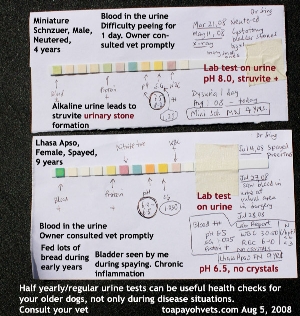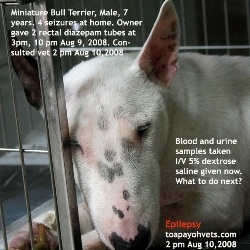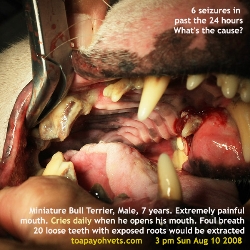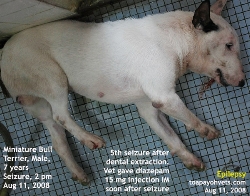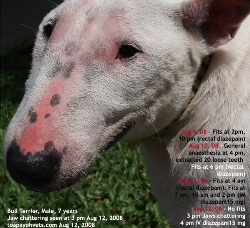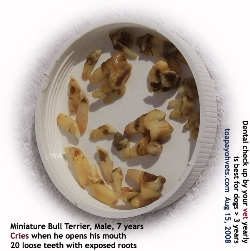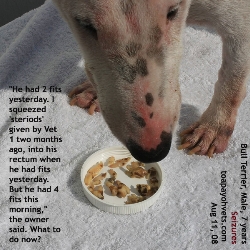The owner has to accept the high risk that his epileptic old dog may die on the operating table
|
Slyvester's owner
consulted me one day some two years ago for a second
opinion. Slyvester had been licking his paw and one big
red skin lump of over 2 cm in diameter appeared. Vet 1
had recommended surgery to remove the growth. "It could be a lick granuloma," I said. "Let me know if my anti-inflammatory injection and antibiotics worked. You still have to clean the skin lump daily." Surprisingly the lump disappeared as I anticipated that surgery would be required for such a big lump. I visited Slyvester a few times as he always go to the owner's office. He jogged with the owner every morning and was as slim and fit as the owner. When he had a fit on May 14, 2008, the owner phoned me: "What is the cause?" I referred the owner to the competition as I wanted the owner to have a different opinion. Fits are hard to treat unless the cause is known and so a different opinion would be good for Slyvester. One of the causes of fits is bacterial infection of the brain. Now, Slyvester had a very foul breath in 2008 and would not let me examine his mouth. His owner could not do it too. Despite several advices to do dental check up, the owner was not keen. General anaesthesia in an old dog would be risky and Slyvester might die. So, it was better to have a bad breath dog rather than a dead one from an owner's point of view. On August 10, 2008, Slyvester came in after suffering 6 fits within 24 hours. "I gave Slyvester 'steroids' in his rectum twice," the owner said. "The other vet had given them to me in May when Slyvester had his first fit." "What is the name of the 'steroids?" I asked. "They must be rectal diazepam tubes". As the owner did not bring his medication to me, I asked him to go home to get them. The 'steroids' were 5 mg rectal gel tubes named 'Stesolid'. Now, how should this case be managed? There was one possible cause of Slyvester's epilepsy. A high fever caused by bacterial infection. The source of the bacteria would be most likely from the foul mouth. There could be other sources but the mouth had plenty of stinking bacteria. A high fever would cause the fits but since Slyvester was given 2 rectal tubes of diazepam which controlled fits and lower the body temperature, Slyvester had no fever and no fit on his arrival at the surgery. "It is never easy to diagnose the cause of epilepsy in any older dog," I said to the owner. "Blood and urine tests will be taken for testing. It is possible that bacteria from the decayed teeth have had caused a high fever and damaged Slyvester's brain." Slyvester did not have fits now. He was given an IV drip of 5% dextrose saline. I said to the owner: "You have to take the risk of Slyvester dying on the operating table today. He may die under general anaesthesia to remove the decayed teeth to get rid of the bacteria. This may be the last time you will see Slyvester alive." Anaesthesizing a dog with epilepsy is very high risk. Why not wait till his epilepsy was controlled. But procrastination might give time for more bacteria to further damage the brain tissues. It was possible that the physical damage of the brain by the bacterial toxins had been done. It was better not to wait. At this time, I felt quite angry that the dental work could have been done after Slyvester's first fit and before that. The owner just ignored my advices and I felt sorry for Slyvester whenever I see him. Only 2 weeks ago, Slyvester's owner took me around Mount Sophia with Slyvester to pick up some 'organic' mangoes littering the roads. They were organic in the sense that the mango trees were not farmed commercially and therefore are healthier with no insecticides. I went with Slyvester and the owner to gather some mangoes and Slyvester appeared his drowsy self. Slyvester seemed to have a very high tolerance to toothache as in many dogs of the bull terrier breed. The owner would be worried that Slyvester would die under general anaesthesia. Slyvester had no problem during his first general anaesthesia when I removed 9 loose teeth some 2 years ago. But he was much older now. From the owner's point of view, why tempt the God of death? But what choice has he got now? 6 seizures. More would come. The owner understood and accepted the high risk of general anaesthesia. If Slyvester had a seizure during anaesthesia, he would die. And it was hard to forecast when the next seizure would come. Slyvester had 2 vials of diazepam rectally given by the owner. So he could not fight back much as I put the gas mask onto him. He could still move his mouth away with his muscular neck and two men had to hold onto him. The minimal gas amount was used. No intubation was possible as he had a very painful mouth. Ulcers and bleeding in the gums. 20 loose teeth were removed. 4 strong canine teeth and a molar with exposed root were the remaining strong teeth left. Slyvester did not have a fit. He survived the general anesthesia. Then he had a fit 2 hours later. And more seizures. Was his brain irreversibly damaged now? How to help him live a normal life? More veterinary follow ups are necessary for Slyvester. The record of the history and follow up to August 14, 2008 is written below. |
||||||||
Thursday, August 14, 20089. Epilepsy in a 7-year-old Miniature Bull Terrier (draft blog)
Epilepsy
- 7-year-old Miniature Bull Terrier
May 14, 08. One fit. I asked the owner to consult the competition as it would be good for the owner and Slyvester to get a different first opinion. Causes of fits in the older dog are notoriously difficult to find out. The vet said that there was nothing abnormal in Slyvester's blood test and examination. The vet prescribed phenobarb 30 mg and advised 2.5 tablets 2 times per day for 2 weeks. The owner was told that Slyvester would need the drug for life. Slyvester did not complete the 2 week of medication. As to the cause of this fit, it was not possible to pin point. The owner had antibiotics given. I advised dental examination under general anaesthesia some months before and even after the first fit to remove bacteria multiplying in Slyvester's mouth. Slyvester had objected to any mouth touch and always looked lethargic with his head down whenever I visited his owner at the office. As there was the possibility of deaths under general anaesthesia, the owner was not keen on my recommendation. More than one year ago, I had extracted 9 decayed teeth from Slyvester under general anaesthesia but the bad breath had returned in 2008. Slyvester is fed mainly home-cooked food. His coat condition is normal. His weight is normal and he exercised with his owner by jogging every morning around Mount Sophia area. Therefore hypothyroidism as a cause of his lethargy was ruled out. Aug 9 08. National Day, Singapore Slyvester At home 2 pm lst fit (Stesolid rectal tube with 5 mg diazepam gel given by owner) > 45 sec 10 pm 2nd fit (Stesolid rectal tube with 5 mg diazepam gel given by owner) > 45 sec Aug 10 08. Sunday Slyvester At home 7am 3rd fit (toilet roll into mouth to prevent tongue biting). 8 am 4th fit 8.30 am 5th fit 10 am 6th fit Shorter 15 sec. "Massage his shoulder and talk to him," the owner said. "Fits become shorter in duration when I massage him. I also stuffed thick towel into mouth to prevent tongue biting." "Why didn't you give Slyvester the rectal diazepam," I asked. : "I wanted to observe how often he gets fits." Epilepsy
- 7-year-old Miniature Bull Terrier
Aug 12, 08.
Aug 13, 08. "Various causes of epilepsy include hereditary causes in dogs less than 5 years old but Slyvester is 7 years old, damage to the brain by injury, toxins and diseases. In Slyvester's case, total white cell count from blood sample revealed higher than normal. I believe it would be that Slyvester's brain was infected. Encephalitis caused by bacteria leading to high fever and convulsions on National Day. The most obvious location of bacteria would be from the mouth. 20 loose teeth with exposed roots were infected and extracted. Also, the extreme pain
in his mouth may finally aggravate his fits." Will
need to monitor closely. If the cause of the
fits is the mouth bacteria and the brain
damage is not lasting, it is possible that
Slyvester need not go onto anti-epileptic
medication for life as he now has epilepsy
with a cluster of 11 fits. |
||||||||
|
A GOOD
REPORT ON SLYVESTER FROM A LAYMAN'S POINT OF VIEW WRITTEN BY MS TAN XINRU, A 2ND YEAR VICTORIA JUNIOR COLLEGE STUDENT SEEING PRACTICE AT TOA PAYOH VETS Sunday August 10, 2008 A bull terrier was brought in later in the afternoon for a blood test. His stomach hurt when touched and could only be carried at the shoulders and hind legs. It had suffered from fits in May and had a relapse yesterday. The previous blood test at (the name of competiting vet practice) showed no anomalies. The fits last around 30-45 seconds and subsided when some medicine was inserted through the anus. It lasts 8 hours before the fits return again. His spine was prodded and the dog whined when the middle back was pressed, indicating pain, as when the stomach was pressed. Blood samples were taken (3 tubes) and sent to the lab. Two samples were taken to verify the consistency of the results. The dog yelps in pain when it yawns, not surprising when you look at the state of its teeth. Most were rotting away. The teeth were extracted as quickly as possible, gassing the dog at intervals to minimise the pain. The pain from the decaying teeth could be cause of the fits. A urine sample was also taken, which hinted at a problem in the kidneys. After the majority of his teeth were removed, the remaining were scaled. The dog was then put on a drip and left to rest. However, he had a fit about an hour later.
Ms Tan
commenced her seeing practice in August 2008. She
intends to study veterinary medicine and surgery
after her A levels in 2009. |
 TOA
PAYOH VETS
TOA
PAYOH VETS